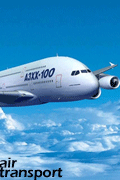Thursday, April 9, 2009
With the stroke of a pen, the FAA on April 7 agreed to work in cooperation with China to share best environmental practices at airports in the two countries. The agreement was reached at the U.S.-China Aviation Symposium in Beijing.
The FAA's acting assistant administrator for international aviation, Di Reimold, joined representatives from the U.S. Trade and Development Agency and the Civil Aviation Administration of China in signing the Memorandum of Understanding that outlines the agreement.
The agreement is designed to enhance U.S. and Chinese aviation. It's a relationship that "continues to mature. It's just continuing to grow," said Gene Kingsbury, who manages the FAA's Asia-Pacific Division.
While the environment is an important part of the symposium, officials also concentrated on air traffic and safety.
"Today, expectations have changed, and we are constantly challenging ourselves to find new ways to improve the safety of our aviation system," Reimold said. "That's why these meetings are so important. Aviation is a global endeavor. If we are going to someday achieve a truly seamless global aviation system and the highest level of safety possible, we are going to need to work together."
Reimold also highlighted cooperation in developing China's plans to modernize its air traffic system and flight safety rules.
"I believe that the United States and China, which represent the two largest aviation systems in the world, have an obligation to the global community to lead the way in aviation cooperation," Reimold said.
The aviation industry in China has witnessed tremendous growth in the past two decades. As the country has opened more to foreign nationals and tourists, the need for airports that are both bigger and better has grown along with that demand. Before the 2008 Summer Olympics in Beijing, the country built one of the premier terminals in the world at its Beijing Capital International Airport. News reports put the terminal at twice the size of the Pentagon - making it one of the biggest buildings in the world - with the capability of handling 50 million passengers a year.
The FAA's acting assistant administrator for international aviation, Di Reimold, joined representatives from the U.S. Trade and Development Agency and the Civil Aviation Administration of China in signing the Memorandum of Understanding that outlines the agreement.
The agreement is designed to enhance U.S. and Chinese aviation. It's a relationship that "continues to mature. It's just continuing to grow," said Gene Kingsbury, who manages the FAA's Asia-Pacific Division.
While the environment is an important part of the symposium, officials also concentrated on air traffic and safety.
"Today, expectations have changed, and we are constantly challenging ourselves to find new ways to improve the safety of our aviation system," Reimold said. "That's why these meetings are so important. Aviation is a global endeavor. If we are going to someday achieve a truly seamless global aviation system and the highest level of safety possible, we are going to need to work together."
Reimold also highlighted cooperation in developing China's plans to modernize its air traffic system and flight safety rules.
"I believe that the United States and China, which represent the two largest aviation systems in the world, have an obligation to the global community to lead the way in aviation cooperation," Reimold said.
The aviation industry in China has witnessed tremendous growth in the past two decades. As the country has opened more to foreign nationals and tourists, the need for airports that are both bigger and better has grown along with that demand. Before the 2008 Summer Olympics in Beijing, the country built one of the premier terminals in the world at its Beijing Capital International Airport. News reports put the terminal at twice the size of the Pentagon - making it one of the biggest buildings in the world - with the capability of handling 50 million passengers a year.
posted by transport blogs
@ 11:45 PM
permanent link | Post a Comment
|
![]()









